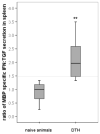Sensitization and tolerization to brain antigens in stroke
- PMID: 18706487
- PMCID: PMC2684331
- DOI: 10.1016/j.neuroscience.2008.07.027
Sensitization and tolerization to brain antigens in stroke
Abstract
Despite encounter of novel brain antigens by the systemic immune system following stroke, autoimmune responses to these antigens do not seem to occur. In rats, a systemic inflammatory response at the time of stroke, however, provokes changes that increase the likelihood of developing detrimental autoimmunity. These findings may help to explain why infections in the post-stroke period are associated with worse outcome. In addition, data suggest that the immune response can be manipulated in an antigen specific fashion to improve stroke outcome. Together these data argue that the nature of the post-ischemic immune response influences neurological recovery from stroke.
Figures




Similar articles
-
Systemic infection, inflammation and acute ischemic stroke.Neuroscience. 2009 Feb 6;158(3):1049-61. doi: 10.1016/j.neuroscience.2008.08.019. Epub 2008 Aug 22. Neuroscience. 2009. PMID: 18789376 Review.
-
Post-stroke immunodeficiency: effects of sensitization and tolerization to brain antigens.Int Rev Immunol. 2012 Oct;31(5):396-409. doi: 10.3109/08830185.2012.723078. Int Rev Immunol. 2012. PMID: 23083348 Review.
-
Induction of immunologic tolerance to myelin basic protein prevents central nervous system autoimmunity and improves outcome after stroke.Stroke. 2008 May;39(5):1575-82. doi: 10.1161/STROKEAHA.107.501486. Epub 2008 Mar 6. Stroke. 2008. PMID: 18323496 Free PMC article.
-
Autoimmune responses to the brain after stroke are associated with worse outcome.Stroke. 2011 Oct;42(10):2763-9. doi: 10.1161/STROKEAHA.111.619593. Epub 2011 Jul 28. Stroke. 2011. PMID: 21799171 Free PMC article.
-
Autoimmunity After Ischemic Stroke and Brain Injury.Front Immunol. 2019 Apr 2;10:686. doi: 10.3389/fimmu.2019.00686. eCollection 2019. Front Immunol. 2019. PMID: 31001280 Free PMC article. Review.
Cited by
-
A longitudinal study of the post-stroke immune response and cognitive functioning: the StrokeCog study protocol.BMC Neurol. 2020 Aug 26;20(1):313. doi: 10.1186/s12883-020-01897-9. BMC Neurol. 2020. PMID: 32847540 Free PMC article.
-
Antigen-specific immune reactions to ischemic stroke.Front Cell Neurosci. 2014 Sep 12;8:278. doi: 10.3389/fncel.2014.00278. eCollection 2014. Front Cell Neurosci. 2014. PMID: 25309322 Free PMC article. Review.
-
Stroke patients develop antibodies that react with components of N-methyl-D-aspartate receptor subunit 1 in proportion to lesion size.Stroke. 2013 Aug;44(8):2212-9. doi: 10.1161/STROKEAHA.113.001235. Epub 2013 May 30. Stroke. 2013. PMID: 23723305 Free PMC article.
-
Anti-inflammatory effect of cholera toxin B subunit in experimental stroke.J Neuroinflammation. 2016 Jun 13;13(1):147. doi: 10.1186/s12974-016-0610-y. J Neuroinflammation. 2016. PMID: 27296014 Free PMC article.
-
Inflammatory Disequilibrium in Stroke.Circ Res. 2016 Jun 24;119(1):142-58. doi: 10.1161/CIRCRESAHA.116.308022. Circ Res. 2016. PMID: 27340273 Free PMC article. Review.
References
-
- Abraha HD, Butterworth RJ, Bath PM, Wassif WS, Garthwaite J, Sherwood RA. Serum S-100 protein, relationship to clinical outcome in acute stroke. Ann Clin Biochem. 1997;34:366–370. - PubMed
-
- Aslanyan S, Weir CJ, Diener HC, Kaste M, Lees KR. Pneumonia and urinary tract infection after acute ischaemic stroke: a tertiary analysis of the GAIN International trial. Eur J Neurol. 2004;11:49–53. - PubMed
-
- Backstrom E, Chambers BJ, Kristensson K, Ljunggren HG. Direct NK cell-mediated lysis of syngenic dorsal root ganglia neurons in vitro. J Immunol. 2000;165:4895–4900. - PubMed
-
- Barone FC, Arvin B, White RF, Miller A, Webb CL, Willette RN, Lysko PG, Feuerstein GZ. Tumor necrosis factor-alpha. A mediator of focal ischemic brain injury. Stroke. 1997;28:1233–1244. - PubMed
-
- Becker K, Kindrick D, McCarron R, Hallenbeck J, Winn R. Adoptive transfer of myelin basic protein-tolerized splenocytes to naive animals reduces infarct size: a role for lymphocytes in ischemic brain injury? Stroke. 2003;34:1809–1815. - PubMed
Publication types
MeSH terms
Substances
Grants and funding
LinkOut - more resources
Full Text Sources
Other Literature Sources
Medical

